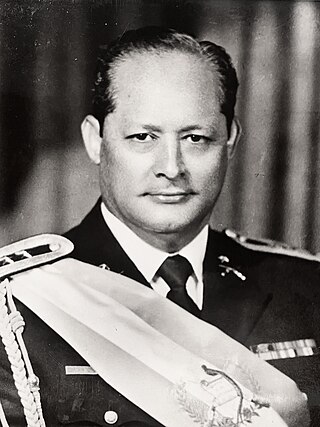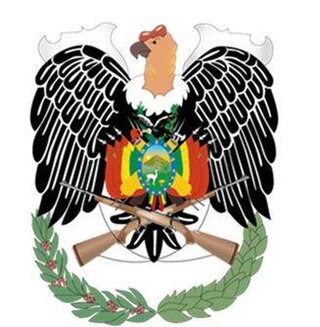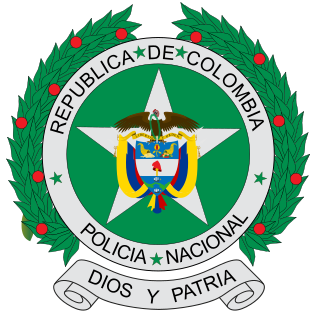Related Research Articles

The Public Force of Costa Rica is the national law enforcement agency of Costa Rica, whose duties include internal security and border control.

Óscar Humberto Mejía Víctores was a Guatemalan military officer and politician who served as the Head of Government from August 1983 to January 1986. A member of the military, he was head of state during the apex of repression and death squad activity in the Central American nation. When he was minister of defense, he rallied a coup against President Ríos Montt, which he justified by declaring that religious fanatics were abusing the government. He allowed for a return to democracy, with elections for a constituent assembly being held in 1984, followed by general elections in 1985.

Carlos Manuel Arana Osorio was a military officer and politician who served as the 35th president of Guatemala from 1970 to 1974. A member of the National Liberation Movement, his government enforced torture, disappearances, and killings against political and military adversaries, as well as common criminals.

The Kempeitai was the military police of the Imperial Japanese Army (IJA). The organization also shared civilian secret police that specialized clandestine and covert operation, counterinsurgency, counterintelligence, HUMINT, interrogate suspects who may be allied soldiers, spies or resistance movement, maintain security of prisoner of war camps, raiding to capture high-value targets, and providing security at important government and military locations at risk of being sabotaged roles within Japan and its occupied territories, and was notorious for its brutality and role in suppressing dissent. The broad duties of the Kempeitai included maintaining military discipline, enforcing conscription laws, protecting vital military zones, and investigating crimes among soldiers. In occupied areas, it also issued travel permits, recruited labor, arrested resistance, requisitioned food and supplies, spread propaganda, and suppressed anti-Japanese sentiment. At its peak at the end of World War II, the Kempeitai was an extensive corps with about 35,000 personnel.

Allan Nairn is an American investigative journalist. He was imprisoned by Indonesian military forces under United States-backed strongman Suharto while reporting in East Timor. His writings have focused on U.S. foreign policy in such countries as Haiti, Guatemala, Indonesia, and East Timor.
PMA may refer to:

The Guatemalan Civil War was a civil war in Guatemala which was fought from 1960 to 1996 between the government of Guatemala and various leftist rebel groups. The Guatemalan government forces committed genocide against the Maya population of Guatemala during the civil war and there were widespread human rights violations against civilians. The context of the struggle was based on longstanding issues of unfair land distribution. Wealthy Guatemalans, mainly of European descent and foreign companies like the American United Fruit Company had control over much of the land. They paid almost zero taxes in return–leading to conflicts with the rural indigenous poor who worked the land under miserable terms.

Law enforcement in Bolivia is reliant on the 40,000-member Cuerpo de Policía Nacional responsible for internal security and maintaining law and order. Unlike many South American countries, the Bolivian police force always has been accountable to the national government rather than to state or local officials. The 1950 Organic Law of Police and Carabiniers officially separated the police from the military. Frequently, however, the national police call upon the military for assistance in quelling riots and civil protests.

The National Police of Colombia is the national police force of the Republic of Colombia. Although the National Police is not part of the Military Forces of Colombia, it constitutes along with them the "Public Force" and is also controlled by the Ministry of Defense. The National Police is the only civilian police force in Colombia. The force's official functions are to protect the Colombian nation, enforce the law by constitutional mandate, maintain and guarantee the necessary conditions for public freedoms and rights and to ensure peaceful cohabitation among the population.
Law enforcement in Spain is carried out by numerous organizations, not all of which operate in the same areas.

The Carabineros de Chile are the Chilean national law enforcement gendarmerie, who have jurisdiction over the entire national territory of the Republic of Chile. Created in 1927, their mission is to maintain order and enforce the laws of Chile. They reported to the Ministry of National Defense through the Undersecretary of Carabineros until 2011 when the Ministry of the Interior and Public Security gained full control over them. They are in practice separated fully from the three other military branches by department but still are considered part of the armed forces. Chile also has an investigative police force, the Investigations Police of Chile, also under the Interior and Public Security Ministry; a Maritime Police also exists for patrol of Chile's coastline.

Guatemalan law enforcement, mainly performed by the civilian-led National Civil Police of Guatemala(PNC), yet assisted by its military, which has a poor record with regard to human rights violations. During President general Otto Pérez Molina, elected in 2012, stepped up the use of military reinforcement in the country's law enforcement, which was introduced in 2005 as a 'temporary measure' yet lasted several electoral periods. During the country's civil war from 1960 to 1996, 200,000 people were killed and 45,000 forcibly disappeared.
Law enforcement in Albania is the responsibility of several agencies. The responsibility for most tasks lies with the Albanian State Police, a national police agency, which is under the authority of Ministry of Internal Affairs. Examples of other agencies with limited policing powers are the Municipal Police, which has administrative functions and operates in the local level. They are controlled by mayors.
The U.S. Central Intelligence Agency (CIA) has a history of interference in the government of Guatemala over the course of several decades. Guatemala is bordered by the North Pacific Ocean and the Gulf of Honduras. The four bordering countries are Mexico, El Salvador, Honduras and Belize. Due to the proximity of Guatemala to the United States, the fear of the Soviet Union creating a beachhead in Guatemala created panic in the United States government during the Cold War. In an interview, Howard Hunt, CIA Chief, Mexico, stated that "We were faced here with the obvious intervention of a foreign power, because these home grown parties, are not really home grown, they are being funded...or advised by a foreign power, i.e. the Soviet Union." The CIA undertook Operation PBSuccess to overthrow the democratically elected Jacobo Árbenz in the 1954 Guatemalan coup d'état. Carlos Castillo Armas replaced him as a military dictator. Guatemala was subsequently ruled by a series of military dictatorships for decades.

The Guatemalan genocide, also referred to as the Maya genocide, or the Silent Holocaust, was the mass killing of the Maya Indigenous people during the Guatemalan Civil War (1960–1996) by successive Guatemalan military governments that first took power following the CIA instigated 1954 Guatemalan coup d'état. Massacres, forced disappearances, torture and summary executions of guerrillas and especially civilians at the hands of security forces had been widespread since 1965, and was a longstanding policy of the military regime. Human Rights Watch (HRW) has documented "extraordinarily cruel" actions by the armed forces, mostly against civilians.
The Secret Anti-Communist Army was a front organization that operated in Guatemala and El Salvador during the Guatemalan Civil War. Like other earlier organizations, such as the MANO and the CADEG, the ESA existed as a front for a covert program of selective assassination by the Guatemalan security services. The first documentation of it came from the New York Times on 4 August 1977.

The Policía Armada, conventional long names Cuerpo de Policía Armada y de Tráfico and Fuerzas de Policía Armada, —popularly known as los grises owing to the color of their uniforms— was an armed urban police force of Spain established by the Francoist regime in 1939 to enforce the repression of all opposition to the regime. Its mission was "total and permanent vigilance, as well as repression when deemed necessary."
The Treasury Guard, also known as the Treasury Police, was a police agency active in Guatemala from 1954 until 1997 when it was formally abolished along with the National Police and the PMA as a result of the peace accords which ended the 36-year Guatemalan Civil War.
The National Police of Honduras is the uniformed police force of the Republic of Honduras. The force is organised into regional headquarters, municipal headquarters, headquarters of fixed or mobile stations, and police posts. There are at least 360 police centres throughout Honduras. The National Police of Honduras has its headquarters in Tegucigalpa, the capital city of Honduras. The National Police of Honduras is the fourth largest police body in Central America by number of employees. It is the sixth largest force in Central America by police officers per capita. The force's patroness is the Virgin of Carmen. On 16 July of each year the "National Police Patroness Day" is celebrated.

The National Civil Police is the police force of Guatemala and is an agency of the Guatemalan Ministry of the Interior. The PNC is in charge of protecting public order.
References
- ↑ Inforpress Centroamericana. Email to INS Resource Information Center (Washington, DC: 21 May 2001).
- ↑ Navy Captain Julio Alberto Yon Rivera (former G-2 director), 1996 interview
- ↑ Cited in Memory of Silence: The Guatemalan Truth Commission Report (1999), p. 104
- ↑ "Guatemala: Alliances Unlimited," LATIN AMERICAN NEWSLETTERS, LTD. (19 November 1976), p. 354.
- ↑ Amnesty International. As cited in Jonathan L. Fried, Marvin E. Gettleman, Deborah T. Levenson and Nancy Peckenham, eds. GUATEMALA IN REBELLION: UNFINISHED HISTORY (New York, NY: Grove Press, 1983), p. 139-145.
- ↑ IACHR, Number 3497
- ↑ Nairn, Allan and Simon, Jean Marie. "Bureaucracy of Death," THE NEW REPUBLIC (30 June 1986)-as reported on Lexis-Nexis.
- ↑ EFE News Service. "Guatemalan Garrison to be Excavated in Search for Victims' Bones" (3 October 1999)-as reported on Lexis-Nexis.
- ↑ Inforpress 2001, 1